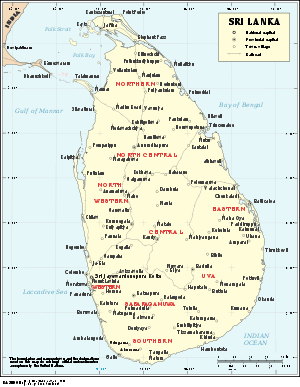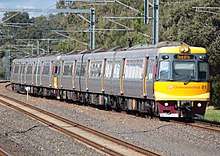Rail transport in Sri Lanka
| Rail transport in Sri Lanka | |||||||
|---|---|---|---|---|---|---|---|
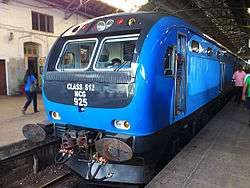 Intercity train at a station | |||||||
| Operation | |||||||
| National railway | Sri Lanka Railways | ||||||
| Major operators |
Sri Lanka Railways, (most services) Airport & Aviation Services Limited, (Airport Express) J.F. Tours & Travels (Ceylon) Ltd (Viceroy Special)[1] | ||||||
| Statistics | |||||||
| Ridership | 300,000 per day | ||||||
| System length | |||||||
| Total | 1,508 kilometres (937 mi) | ||||||
| Track gauge | |||||||
| Main | 5 ft 6 in (1,676 mm) broad gauge.[2] | ||||||
| Electrification | |||||||
| Electrified | 0 km (0 mi)[3][4] | ||||||
| Features | |||||||
| No. stations | 320 | ||||||
| Highest elevation | 1,900 metres (6,200 ft) at Pattipola (highest broad gauge railway in the world[2]) | ||||||
| |||||||
Rail transport in Sri Lanka is an intercity network connecting major population centres and commuter rail serving Colombo commuters. State-run Sri Lanka Railways, originally known as Ceylon Government Railways, is the nation's railway and primary operator.
The railways were conceived in the 1850s to develop and unify Sri Lanka. Service began in 1864, with the construction of the Main Line from Colombo to Ambepussa 54 kilometres (34 mi) to the east. During the first half of the 20th century a tram system operated in Colombo, carrying commuters within the city.
The railway now moves 300,000 passengers daily on 324 trains between 320 stations across the country. At a peak of 1,900 metres (6,200 ft), Sri Lanka has the highest broad-gauge railway in the world.[2]
History
The railway was initially built to transport coffee and tea from the hill country to Colombo for export, and transporting such goods was the main source of income on the line for many years. With time and population growth, however, passenger traffic increased. During the 1960s, passenger traffic overtook freight as the main source of revenue.[5] The railway is now primarily engaged in passenger transport, especially commuters to and from Colombo (helping to reduce road congestion).
The railway moves 300,000 passengers daily on 324 trains between 320 stations across the country.[6] Despite overcrowding, its share of the passenger market is only seven percent and it handles two percent of the freight market.[7]
The railway is being modernised under the government's 10-year Railway Development Strategy.[8] New train sets are being imported[9] and track upgraded.[10] In an effort to increase public support for rail transport, premium services were introduced through the private sector on some lines.[11][12]
Freight service made up most of the railways' revenue. During the 1960s, passenger traffic overtook freight; most container traffic shifted to road transport, often leading to logistical challenges and delays.[5]
The railways revived the link to the Port of Colombo in 2011, enabling bulk movement of cargo and generating less pollution. A train can generally carry 20 to 24 twenty-foot equivalent container units, greatly improving the efficiency of freight transport and making cargo easier to track.[5]
Operators
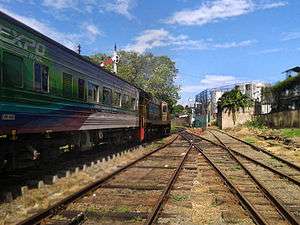
Sri Lanka Railways operates nearly all rail services in the country. A state-owned enterprise, Sri Lanka Railways operates passenger intercity and commuter rail and freight transport.
Private operators provide some services with Sri Lanka Railways' equipment and infrastructure. The Viceroy Special, a heritage train with a preserved steam locomotive, is operated by J. F. Tours & Travels.[1][13] Airport & Aviation Services Limited operates the Airport Express between Colombo's Secretariat Station and Bandaranaike International Airport.
On 6 October 2011, Expolanka introduced its ExpoRail premium service;[11][14] the Blue Line Company introduced a competing service, the Rajadhani Express, the same day. ExpoRail and Rajadhani operate a premium section on trains operated by Sri Lanka Railways.[11][12] Colombo's tram system was operated by the Colombo Electric Tram Car and Lighting Company before it was taken over by the municipal council and shut down.
Locomotives
Until 1953, Sri Lankan Railways operated steam locomotives. During the mid-twentieth century, it converted to diesel locomotives under the leadership of B. D. Rampala. Several types of diesel locomotives were added to the service from manufacturers including Japan's Hitachi, the US' General Motors and Canada's Bombardier.[2]
Network
The 1,508-kilometre (937 mi) Sri Lankan railway network is 5 ft 6 in (1,676 mm) broad gauge.[2] All service is diesel-powered.[15] The network is divided into three operating regions based in Colombo, Anuradhapura and Nawalapitiya.[16][5] The railway is currently modernising and extending the Coast Line to facilitate faster trains and improved efficiency.[17]
Electrification
Although electrification was first proposed in 1928, the Cabinet did not approve the electrification of suburban railways until 2015. Electrification of the Panadura-Veyangoda line is proposed in phase one of the Western Region Megapolis plan with a soft loan from the Asian Development Bank.[18][19][20]
A contract has been signed by Malaysia's Airport Express Air and Rail Company and the government of Sri Lanka for new electric rail line between Negombo and Colombo. The project is expected to be completed by 2018.[21] Electrification of the busiest sections of the network was proposed several times to improve energy efficiency and sustainability. Around 1998, the Institution of Engineers, Sri Lanka (IESL) submitted recommendations for railway electrification. Although they were approved by the cabinet, they were not implemented. IESL made new proposals for electrification in 2008 and 2010, but no work was done because the voltage systems were undefined. System electrification is favoured by the IESL to reduce pollution, increase passenger comfort and lessen travel time.[4][22]
Sri Lanka Railways is planning to electrify the 120-kilometre (75 mi) Colombo commuter-rail system from Veyangoda to Maradana, Maradana to Kaluthara and Ragama to Negombo, but their voltage systems are unknown. Fifteen electric multiple units will be imported for commuter service.[23]
Signalling
Much of the network uses a lock-and-block signaling system. During the mid-twentieth century, the busiest sectors (around Colombo) were upgraded to electronic signalling connected to a CTC control panel at the Maradana railway station.[2]
In 2011, a project to add electronic signalling to the northern lines began. Track between Anuradhapura, Kankesanturai, and Talaimannar would have electronic signalling with centralised traffic control, using an interlocking colour-light system with electrically-operated points and a track-detection system. Level crossings would be connected to the signalling system, ensuring safety.[24]
After the 2011 Alawwa rail accident, SLR began installing a GPS-based train-protection system on its entire fleet. The system warns a train driver of a possible collision in time to manually stop the train. The fleet can also be monitored by a central control room with the system. A trial run was conducted in early November 2011 with ten trains.[25][26]
Routes
Major population centres and tourist destinations are connected by rail. Service began in 1864 with the construction of the Main Line from Colombo to Ambepussa, 54 kilometres (34 mi) east, and the first train ran on 27 December 1864. The line was officially opened to traffic on 2 October 1865. The Main Line was extended in stages, with service to Kandy in 1867, to Nawalapitiya in 1874, to Nanu-Oya in 1885, to Bandarawela in 1894, and to Badulla in 1924.[27] Other lines were completed to link the country: the Matale Line in 1880, the Coast Line in 1895, the Northern Line in 1905, the Mannar Line in 1914, the Kelani Valley Line in 1919, the Puttalam Line in 1926, and the Batticaloa and Trincomalee Lines in 1928.[28]
Main Line
The Main Line starts from Colombo and runs east and north past the developing centres of Ragama, Ganemulla Gampaha, Veyangoda, Mirigama, Ambepussa and Polgahawela. At Rambukkana, the line begins a steep climb into the hills. Between Balana and Kadugannawa the track runs along the edge of sheer cliffs, allowing passengers a view of Batalegala.
The Main Line then continues climbing through tea country, connecting market centers at Gampola, Nawalapitiya and Hatton before reaching Nanu-Oya. This is the connection to the former colonial resort of Nuwara Eliya, still visited for its temperate climate, classic hotels and British-style gardens. The Main Line reaches its summit at Pattipola, 6,226 feet (1,898 m) above sea level, before descending past Bandarawela to Badulla. Passengers can view tea gardens, mountains, valleys and waterfalls.
Coastal line
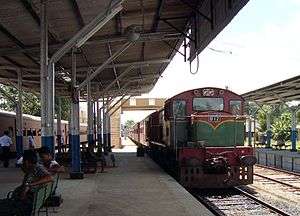
The coastal line runs south from Colombo, following the Indian Ocean, with views of tropical beaches and coconut palm trees. It links the regional centres of Moratuwa, Panadura and Kalutara South, and beach resorts at Aluthgama, Ambalangoda and Hikkaduwa. The line continues past Galle (known for its historic, well-preserved Dutch fort) before terminating at Matara. In 2014, a Chinese company planned to extend the line to Kataragama.[29]
Puttalam line
The Puttalam line branches off the Main Line at Ragama, extending north past Kandana Ja-Ela, Seeduwa, Katunayake and Negombo (a regional tourist centre). It connects northwestern Sri Lanka, reaching Kochikade, Waikkala, Luniwila (and the National Coconut Research Center), Nattandiya, Madampe, Chilaw, Bangadeniya, Mundel and Puttalam.
The line also links other market towns and fishing villages. Passenger service ends at the Noor Nagar station, just north of Puttalam; beyond that, the tracks are used by Holcim trains to haul cement.
Kelani Valley line
The Kelani Valley line extends from Colombo-Maradana east to Avissawella. Originally a narrow-gauge line, it was converted to 5 ft 6 in (1,676 mm) broad gauge between 1991 and 1997. The line connects the suburbs of Colombo in the Colombo District with the city.
Matale line
The Matale line branches off the Main Line at Peradeniya Junction, near the Peradeniya Botanical Gardens. It runs to Kandy, home of the Sri Dalada Maligawa (which houses the relic of the tooth of the Buddha), before descending to Matale.
Northern line
The Northern line branches north from the Main Line at Polgahawela, passing Kurunegala—capital of North Western Province—before continuing to the cultural center of Anuradhapura (the island's capital around the 4th century BCE, and home to many religious and archaeological sites). Service has been extended to the line's terminus at Kankesanthurai on the Jaffna peninsula, past Kilinochchi.[30]
Mannar line
The Mannar line branches westward from the northern line at Medawachchiya, passing Madhu Road—location of the Shrine of Our Lady of Madhu—and continuing to Mannar Island (home of the district capital and terminus of the former Talaimannar line).
Batticaloa line
The Batticaloa line branches eastward from the northern line at Maho to Polonnaruwa, site of an 11th-century capital and home to a number of historic monuments. The line continues to the city of Batticaloa.[31]
Trincomalee line
The Trincomalee line branches north and east from the Batticaloa line at Gal-Oya Junction and extends to Trincomalee.
Mihintale line
The Mihintale line is a short branch line which connects Mihintale (home of the Mihintale Temple, where Thera Mahinda—who brought Buddhism to Sri Lanka—arrived) with Anuradhapura, the capital of Sri Lanka for over 100 years, via the northern line. It branches off the latter at Mihintale Junction and runs eastward to Mihintale (the line's only stations).
Intercity network
The intercity network radiates from Colombo, connecting most major population and industrial centres with passenger and freight service.[5] It includes hubs at Colombo Fort and Maradana.
Passenger services
Most passenger service is provided by Sri Lanka Railways, which connects major cities. Trains generally have three classes, offering several levels of comfort.[32] A number of major trains are named, and have become cultural icons.[33]
Expolanka's ExpoRail and the Blue Line Company's Rajadhani Express offer premium service on some trains.[11][14] Although they do not operate their own trains, they provide service in dedicated carriages on Sri Lanka Railways trains.[11][12]
Urban rail
Commuter trains in Colombo
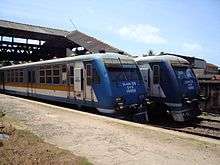
Commuter rail service connects Colombo to its suburbs, helping alleviate rush-hour congestion on city roads. Local commuter trains use the same tracks as the intercity lines. Colombo's commuter-rail network is 100 kilometres (62 mi) of track from Panadura to Polgahawela via the Fort and Maradana stations. The route is multi-tracked to provide rush-hour service.[34] Electrification of the commuter rail network has been proposed, to improve energy efficiency and sustainability.[3][4]
Colombo metro
A 1,435 mm (4 ft 8 1⁄2 in) standard gauge metro system was proposed in the 2010s to give commuters in Colombo a clean, environmentally-friendly transit option. The metro would reduce the load on the overcrowded commuter-rail system and alleviate congestion on major roads.[35] A consortium of three companies is conducting feasibility studies on the project.[36]
Trams in Colombo
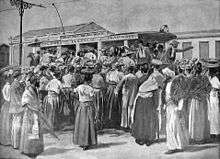
Northern and central Colombo had an electric tram system, operated by the Colombo Electric Tram Car and Lighting Company, which began around 1900.[28] For half a century trams dominated Colombo's roads, carrying thousands of commuters.
The tram system was Cape gauge,[28] with grooved street track. The trams used trolley poles and were of two types: open "toast-rack" and closed centre-entry. After a tram strike the Colombo Municipal Council took over operations, and the system was phased out by 1960.[28] The trams have been scrapped, since there was no incentive at the time to preserve them.
Railbus
In areas without significant demand for commuter trains (such as the Eastern province), railbuses connect towns and cities. Railbus service from Batticaloa and Trincomalee allows passengers to travel between the cities with fewer delays.[37]
Links to India
A proposal to link the railways of Sri Lanka and India never materialised. However, a combined train-ferry-train service known as Boat Mail connected Colombo with Chennai for much of the twentieth century.[38]
A 35 km (22 mi) bridge linking the countries was proposed in 1894, by the consultant engineer for railways in Madras (Chennai). The proposal was seriously considered, and a technical blueprint and cost analysis were made. By 1914, the Mannar line was built to connect Talaimannar on Mannar Island to the Sri Lankan mainland, and the Indian rail network was extended to Dhanushkodi. However, a bridge linking them was not built.[38]
Ferry service connecting the railheads at Talaimannar and Dhanushkodi lasted until the 1960s, when a cyclone destroyed the pier and rail line at Dhanushkodi. The ferry service resumed from the Indian terminus at Rameshwaram, ending due to the Sri Lankan Civil War.[38] A rail bridge (or tunnel) was proposed again during the 2000s, highlighting the benefits of connecting the ports of Colombo and Trincomalee with Chennai.[38]
See also
References
- 1 2 Viceroy Vintage Train Tours Archived 28 August 2011 at the Wayback Machine.
- 1 2 3 4 5 6 "The Island". Rampala regime in the local Railway History. 2010-07-19.
- 1 2 "The Island". Railway Electrification: Let us Start, at least now. 27 March 2010. Archived from the original on 5 July 2010.
- 1 2 3 "Daily News". IESL proposes railway electrification project. 25 December 2010. Archived from the original on 8 March 2012.
- 1 2 3 4 5 "Lanka Business Online". Rail Move: Sri Lanka revives railway link to port. 20 July 2011. Archived from the original on 6 May 2012. Retrieved 21 July 2011.
- ↑ "Daily News". Railway to buy more locos, carriages. 12 May 2007. Archived from the original on 18 February 2013. Retrieved 6 November 2011.
- ↑ "Daily FT". A new paradigm for providing economic services. 3 August 2011. Archived from the original on 1 April 2012. Retrieved 6 November 2011.
- ↑ "Dailynews". Power sets to steam long distance travel. 3 September 2010. Archived from the original on 8 March 2012.
- ↑ "Dailynews". Railway gets new power sets from China. 23 April 2010. Archived from the original on 8 March 2012.
- ↑ "Sunday Observer". Complete overhaul for southern railway. 1 November 2009. Archived from the original on 4 October 2011. Retrieved 14 October 2011.
- 1 2 3 4 5 "NEWS.LK: The Official Government News Portal of Sri Lanka". Sri Lankan railway introduces luxury class Services on Colombo-Kandy rails. 7 October 2011. Archived from the original on 4 April 2012.
- 1 2 3 "Daily Mirror". Expo Rail: Wonder on the track. 2011-10-03. Archived from the original on 2012-05-09.
- ↑ Weerasuriya, Sanath. "'Viceroy Special' rolls on the track for 25 years". The Sunday Times. Retrieved 2011-12-14.
- 1 2 "EXPORAIL". Archived from the original on 5 October 2011. Retrieved 5 October 2011.
- ↑ http://www.infolanka.com/org/mrail/slrails.html
- ↑ "Our Network". Sri Lanka Railways. Archived from the original on 3 December 2011. Retrieved 6 February 2012.
- ↑ "Dailymirror". No trains between Galle and Kalutara South. 23 April 2011. Archived from the original on 4 October 2011.
- ↑ "Panadura-Veyangoda railway to be electrified". www.sundayobserver.lk. Archived from the original on 18 May 2016. Retrieved 15 May 2016.
- ↑ "Projects identification Document V3" (PDF).
- ↑ "Western Region Megapolis From Island To Continent | The Sunday Leader". Retrieved 2016-05-15.
- ↑ "Agreement signed to start Sri Lanka's first elect train system – Video | Adaderana Biz English | Sri Lanka Business News". bizenglish.adaderana.lk. Retrieved 2015-09-20.
- ↑ Farzandh, Jiffry (19 December 2011). "B. D. Rampala - an engineer par excellence". Ceylon Daily News. Archived from the original on 13 January 2012. Retrieved 3 January 2012.
- ↑ "Future Plans". Sri Lanka Railways. Retrieved 2012-02-11.
- ↑ "Asian Tribune". Agreement for supply and installation of Signaling & Telecommunication system for Northern railway network. 2011-08-18.
- ↑ "Daily Mirror". SLR to equip fleet with modern safety devices. 2011-11-21.
- ↑ "ColomboPage". Sri Lanka Railways installs new equipment to prevent accidents. 2011-10-26.
- ↑ "Sunday Observer". Cameos of the past: First train on line to Badulla from Colombo. 19 July 2010. Archived from the original on 3 March 2016.
- 1 2 3 4 http://www.infolanka.com/org/mrail/rroutes.html The Rail Routes of Sri Lanka
- ↑ "Chinese company to get 600 mln USD railway project in Sri Lanka". Global Times. Beijing. Xinhua News Agency. 11 March 2014. Retrieved 13 January 2018.
- ↑ "Archived copy". Archived from the original on 22 September 2013. Retrieved 22 September 2013.
- ↑ "TamilNet". Trains to Batticaloa back on track. 2003-04-12.
- ↑ "A beginner's guide to Train travel in Sri Lanka ..."
- ↑ "The Island". Samudra Devi in a Tangle of Love!. 12 July 2009. Archived from the original on 13 September 2011.
- ↑ http://www.unescap.org/ttdw/Publications/TIS_pubs/tarsc_fulltext_1980.pdf Archived 17 July 2011 at the Wayback Machine. Economic and Social Commission for Asia and the Pacific. Development of the Trans-Asian Railway: Trans-Asian Railway in the Southern Corridor of Asia-Europe Routes. 1999.
- ↑ "The Morning Leader". Opinion – Metro long overdue for Colombo. 27 March 2010. Archived from the original on 24 January 2010. Retrieved 19 July 2010.
- ↑ "Daily News". Foreign-funded Colombo Metro feasibility study begins. 6 December 2006. Archived from the original on 13 January 2012. Retrieved 19 July 2010.
- ↑ "The Island". Eastern Province railbus project commences. 2009-07-30.
- 1 2 3 4 http://infolanka.asia/sri-lanka/transport/the-indo-lanka-land-bridge-reviving-the-proposal The Indo-Lanka Land bridge: Reviving the Proposal
Further reading
- Model Railway Club of Sri Lanka Routes Details.
- Sri Lanka Railways SLR History.
External links
| Wikimedia Commons has media related to Rail transport in Sri Lanka. |
